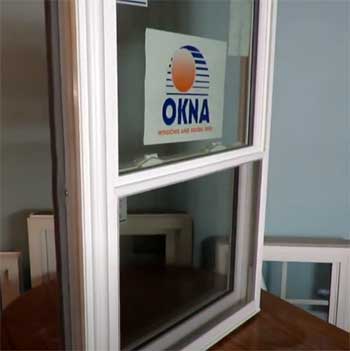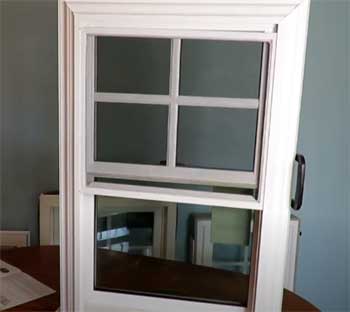If you’re in the market for new windows, you’ve probably come across OKNA windows. As a leading window manufacturer, OKNA offers two popular window series: the 500 and 800 series.
But what’s the difference between these two product lines? And how do you know which is better suited for your home?
In this comparison guide, we’ll break down the key features and benefits of OKNA 500 and 800 series windows. We’ll look at performance, aesthetics, options and upgrades, warranties, and pricing.
By the end, you’ll have a clear understanding of the pros and cons of each series to make an informed decision for your replacement or new construction windows.
A Brief Comparison Table
| Feature | OKNA 500 Series | OKNA 800 Series |
| Frame Material | Vinyl | Vinyl |
| Frame Depth | 1-3/8” pocket & lipped | 1-5/8” pocket |
| Glass Units | 3/4” double pane, LoE 366 | 1” triple pane, LoE 272 |
| Glass Coatings | LoE 366 standard | LoE 272 standard |
| Gas Fill | Argon | Argon |
| Glazing | Double | Triple |
| U-Factor | 0.27 – 0.28 | 0.21 – 0.23 |
| SHGC | 0.27 – 0.32 | 0.23 – 0.28 |
| Condensation Resistance | 51 – 54 | 63 – 70 |
| Sash Operation | Balance coils | Spring-assist counterbalance |
| Weatherstripping | Single | Double |
| Warranty | 10 years parts, 20 years glass | 20 years parts, 30 years glass |
| Price Range | $350 – $700 per window | $700 – $1,200 per window |
Overview of OKNA Windows
Before diving into the nitty-gritty details, let’s step back and look at some background on OKNA as a company.
OKNA Windows is part of the Windows and Doors Group, a division of Jeld-Wen. They manufacture vinyl windows and patio doors for both homeowners and building professionals. The company was founded in 1994 and is based in Entrepreneurial Alley, Pennsylvania.
OKNA aims to make the highest quality vinyl windows at a competitive price point. Their windows consistently earn top ratings and certifications from independent testing agencies. This includes their robust warranties, which we’ll explore more later on.
Now that you know a bit about OKNA, let’s see how two of their most popular product lines stack up.
OKNA 500 Series Overview
The OKNA 500 series is their mid-range vinyl window series. It’s designed to hit that sweet spot between affordability and high-end performance.
Here are some key traits of the 500 series windows:

- Vinyl frame material – 500 series has a heavy-duty uPVC frame and sash for durability and low maintenance. The vinyl color is solid through, meaning scratches are less visible.
- Fusion welded corners – For added strength and protection against air and water infiltration, corners feature internal and external fusion welds.
- Insulated glass units – 500 series has 3/4” double pane LoE 366 insulating glass with argon gas fill in most units. This improves U-Factor and condensation resistance.
- Balance coil spring sash – The sash tilts in with balance coils that allow for easy and safe cleaning from inside your home.
- Reinforced meeting rail – For improved stability and rigidity, the meeting rail has a double-wall extruded reinforcement chamber.
The 500 series frames have a pocket and lipped frame design with a 1-3/8” jamb depth. This gives a traditional double-hung window look with ample installation options.
Overall, the 500 series hits a nice balance point between cost and key components of performance, aesthetics, and durability.
OKNA 800 Series Overview
Stepping up to the 800 series brings some notable upgrades and enhancements. This is OKNA’s premium window series constructed with top-tier components.
Here are some of the defining features of the 800 series:
- Vinyl frame material – Like the 500 series, 800 series has a durable, low-maintenance, color-through uPVC frame and sash. The material thickness is increased to further strengthen the frame.
- TrueSlopeTM sill – The innovative sill has a gradual slope to improve water drainage and performance in extreme weather.
- Neopor® insulated frame – Small Neopor beads fill the interior hollows of the frame and sash, increasing insulation values.
- Insulated glass units – 800 series has 1” triple pane LoE 272 glass units filled with argon for optimal insulation, clarity, and durability.
- Spring-assist counterbalance – The sash tilts in via spring-assist technology that allows for easy operation across the window’s lifetime.
- Double weatherstripping – Weatherstripping on the frame header and sash rails blocks air infiltration and improves energy efficiency.
The 800 series frame design features a pocket frame with a 1-5/8” jamb depth for a sturdy facade. Extruded accessory grooves allow for add-on options down the road.
As you can see, the 800 series takes performance, features, and customization to the next level. But it comes at an increased cost over the value-oriented 500 series.
Key Differences Between OKNA 500 And 800 Series Windows
Performance Comparison
A key difference between the 500 and 800 series lies in thermal performance and efficiency. Let’s look at some of the testing data.
U-Factor
U-Factor measures the rate of heat transfer through the window. The lower the U-Factor, the better the insulation.
- 500 series – U-Factor of 0.27 to 0.28 with LoE 366 glass
- 800 series – U-Factor of 0.21 to 0.23 with LoE 272 glass
Solar Heat Gain Coefficient (SHGC)
SHGC indicates the fraction of solar radiation admitted through the window. Lower SHGC improves comfort in hot climates.
- 500 series – SHGC of 0.27 to 0.32 varying by glass coatings
- 800 series – SHGC of 0.23 to 0.28 varying by glass coatings
Condensation Resistance (CR)
CR measures the window’s ability to resist condensation formation on the interior surface. Higher CR is better.
- 500 series – CR of 51 to 54
- 800 series – CR of 63 to 70
Noise Reduction
Testing shows improved noise dampening with the 800 series triple glazing compared to the 500 series double glazing.
Across the board, the 800 series offers incrementally better thermal efficiency over the 500 series. The upgrade to triple glazing greatly improves insulation while still allowing light transmission.
Aesthetic Options
Both the 500 and 800 series come with ample aesthetic customization options to match your home’s style.
Some of the most popular choices include:

- Vinyl frame colors – Choose from standard colors like white and beige or go for bold hues like brick red, forest green, or black.
- Interior and exterior accessory grooves – Optional grooves accept color-matched vinyl covers and trim pieces for unique facades.
- Glass tinting – Select from tints like bronze, grey, green, and more. Tints can reduce glare and heat gain.
- Decorative glass – Make a statement with patterned glass options like rain, reed, or obscure textures.
- Simulated divided lites (SDL) – Interior and exterior SDLs recreate the look of separate glass panes with grid patterns.
- Hardware finishes – Upgrade to satin nickel, oil rubbed bronze, or brass finished hardware.
The core frames and build quality are identical between the two series. Essentially all of the aesthetic options can be added onto either series. So you won’t sacrifice style preferences by choosing one over the other.
Available Upgrades
As premium vinyl window lines, both the 500 and 800 series offer robust standard features. But OKNA also provides upgrade options to enhance security, functionality, and performance.
Some popular upgrades include:
- Laminated or tempered glass – For protection against forced entry or storm impacts.
- Triple pane glass – For the highest efficiency and soundproofing on 500 series units.
- Obscure or reflective glass – For privacy or energy savings.
- Internal Blinds/Shades – For light filtering between the glass panes.
- High altitude glass – For homes at elevations above 4500 feet.
- Coastal rated glass – With stainless steel spacers for coastal or high humidity regions.
- Precept glass – With thermally optimized spacer for 20% better U-Factor over standard units.
- Argon and Krypton gas – For improved insulation over standard air-filled units.
- Compression & Slide-by sashes – For easier operation with heavy triple pane glass.
- Commercial grade locks & hardware – For forced entry protection.
Again, most upgrades can be spec’d onto either 500 or 800 series windows. So you can always select individual options to fine-tune performance and features.
Warranties
Like most window manufacturers, OKNA backing their products with industry-standard warranties. These provide peace of mind should any defects arise over your windows’ usable lifetime.
Here are the high-level warranties offered:
500 Series Warranty
- 10 years – Against defects in materials and workmanship, covering labor and replacement parts.
- 10 years – On exterior vinyl and hardware finishes against flaking, checking, blistering, corrosion, and loss of adhesion.
- 20 years – Against non-tempered glass seal failure causing impaired visibility due to moisture, film, or dust between glass.
- Lifetime – Against non-tempered glass breakage including accidental glass breakage for 5 years.
800 Series Warranty
- 20 years – Against defects in materials and workmanship, covering labor and replacement parts.
- 10 years – On exterior vinyl and hardware finishes against flaking, checking, blistering, corrosion, and loss of adhesion.
- 30 years – Against non-tempered glass seal failure causing impaired visibility due to moisture, film, or dust between glass.
- Lifetime – Against non-tempered glass breakage including accidental glass breakage for 5 years.
The 800 series extends the coverage duration over the 500 series on the critical components of the vinyl, glass, and workmanship. This matches the longer expected lifespan of the 800 series premium windows.
You can reference the limited lifetime warranties for full terms and details. Overall, both series are backed by strong reassurance from OKNA.
Pricing Differences
As you might expect, the higher-performing 800 series windows come at an increased cost over the budget-friendly 500 series. Exact pricing depends on your window specifications. But you can expect the following:
- 500 series – Roughly $350 to $700 per window
- 800 series – Roughly $700 to $1,200 per window
The 500 series offers notable value for money as a mid-range vinyl window line. The 800 series costs about 2x as much for incremental performance gains.
Whether the upgrades merit the price premium depends on your budget, performance needs, and desired features. In some cases, you can stick with 500 series and add individual options like triple pane glass to enhance efficiency only where needed.
Which Is Right For You?
Now that we’ve compared the key differences, which OKNA window series is better for your home and needs?
Here are a few closing recommendations based on common homeowner profiles:
- Budget-focused – For those focused strictly on value, the 500 series provides quality vinyl windows at lower prices difficult to beat.
- Performance-driven – Homeowners wanting maximum efficiency and noise reduction will get superior results from the 800 series triple glazing.
- Heat and sunlight concerned – For combating drafty cold winters or scorching summers, the 800 series insulation and solar control shine.
- Style and design motived – Both series offer aesthetically identical options to match your desired style.
- Lifetime home – The 800 series with robust glass, frame, and longer warranties make more sense for a forever home you plan to stay in.
- Occasional DIYer – The 500 series lighter double pane sash can be easier to operate for occasional cleaning or maintenance.
Final Thoughts
At the end of the day, partner with a knowledgeable OKNA dealer to review your particular needs. They can break down pricing for your exact window specifications and help you select the ideal series and options.
With two high-quality series offering the core durability of vinyl, either OKNA 500 or 800 series windows will likely satisfy. Go through this guide to gain clarity on the performance and aesthetic differences before deciding on the best selection for your next window project!

